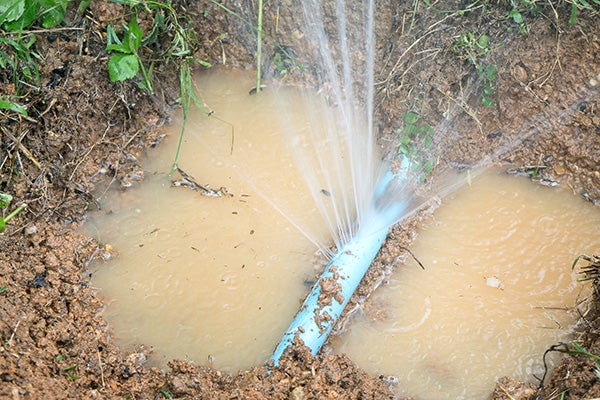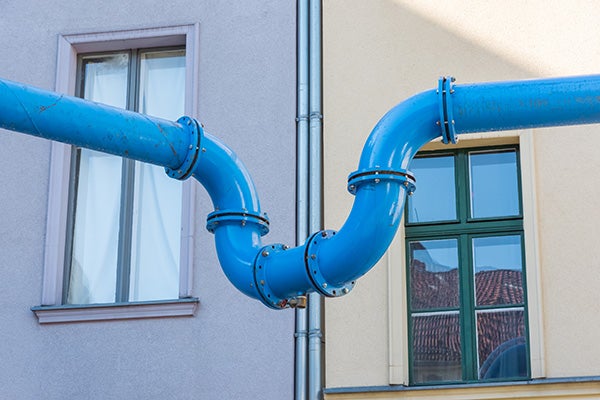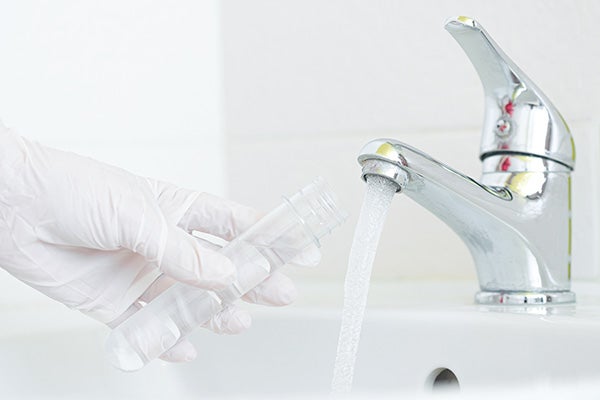Water Quality

Want to know what’s going on with your water? Scroll down to find the answers to the most common water quality questions.

Have a Leak?
If your bill is unusually high due to a leak, we want to make it right. Contact us and we’ll help.
Funny Taste or Smell
Musty and earthy taste and smell
If your water smells musty, make sure that your hot water pipes don’t come into contact with cold water pipes and that all plumbing valves, fittings, and materials are UPC certified. Any section of pipe or taps that aren’t used regularly should be flushed to allow fresh water in. This can be done by turning on the water and letting it run for a few minutes.
Causes of musty and earthy tastes and smells:
- The growth of harmless microorganisms such as bacteria and fungi in pipping can cause musty water that tastes or smells earthy. It’s very common in areas that have low usage or experience local warming –hot pipes coming into contact with cold pipes.
- Sometimes it’s caused by tiny amounts of naturally occurring substances released by algae in raw water reservoirs. At the levels found, these substances are not considered a health hazard. Our water treatment plants reduce the presence of these substances, and we do daily checks on the smell of raw and treated water.
Chlorine taste and smell
We’re required by law to disinfect the public water supply. Most of the time, chlorine-based chemicals are used to ensure that water is safe to drink and free of organisms that could cause illness. The amount of chlorine added is only enough to disinfect the water while minimizing taste and smell.
How is chlorine added?
Chlorine is continuously added at our treatment plants which are monitored 24 hours a day.
Why’s chlorine more noticeable during certain times of the day?
The amount of chlorine in our water supply can vary slightly depending on how far the water must travel through our pipes. Customers who live closer to our water treatment plants may notice chlorine and water smells more often. During a high demand time –first thing in the morning and late afternoon –more people are using water. This means that the water flows to you faster and may contain more chlorine. The concentration of chlorine in the water pipes decreases over time.
We can’t guarantee that your water will never taste or smell like chlorine, and we know that certain customers are more sensitive to it.
To minimize chlorine taste/smell:
- Fill a glass or bottle with tap water.
- Cover it.
- Put it in the refrigerator for about an hour.
- Use the cooled water within 24 hours.
Bitter and metallic tastes and smells
Bitter and metallic tastes and smells are usually cured by running the tap for 3 or 4 minutes to bring in fresh water.
Causes of bitter tastes and smells:
- Water having a metallic or bitter taste is usually caused by an increased amount of metals commonly found in home plumbing systems, such as copper or zinc.
- It can be the result of water standing in pipework for an extended amount of time, or local warming from unlagged hot water or central heating pipes. This tends to be more noticeable in large buildings or those with longer lengths of pipe.
- Also, if you have a water storage tank, check the material it’s made from and the condition it’s in. Turn on your tap to draw fresh water in from the water main supply. When all the water has been drained from your system, you should notice a change in the water temperature.
Chemical tastes and smells
The rubber and plastic materials used in household appliances and fittings are most likely to blame for the chemical taste of your drinking water. Coffee maker gaskets/seals, tap washers, and hoses fitted to the inlet of washing machines and dishwashers are examples of plastic fittings.
These tastes do not come from the water pipes but are formed within the materials that makeup certain items. These plastic and rubber materials contain phenols and other substances that can produce unpleasant tastes or smells. Low levels of chlorine can also react with these materials to create other taste-causing substances.
Although these substances can create unpleasant tastes in hot drinks they do not pose any known health risks at the levels that are usually detected.
Chemical taste can come from one or more of the following factors:
Pressure fluctuation
The pressure of your water supply is somewhat higher at night and when fewer people are using water. This increased pressure can cause expansion in the rubber hoses connected to washing machines and dishwashers. When you turn on a tap on your property, the pressure drops, and the expanded rubber hose collapses, squirting water back into the incoming supply.
Standing water
Water that’s been in your pipes overnight or when your property is vacant is more likely to have taste-causing substances.
Washer deterioration
Washers deteriorate over time. Because the “break down” of washers isn’t a continuous process, the taste may fluctuate.
Fixing the chemical taste and smell
Coffee makers:
Try boiling water in a clean saucepan if you only notice the flavor in hot drinks. If the taste has gone away, it’s most likely due to a failing gasket that seals the components inside the coffee maker. This is most noticeable with new coffee makers. If the coffee maker is new, the problem may go away with time. Using new water each time may keep the flavor to a minimum. If the problem persists, you should contact the manufacturer.
Washing machines and dishwashers:
When water pressure increases it can cause the flexi-hose to expand– when the pressure is released, the hose collapses squirting water back into the incoming supply. This water can then mix with your drinking water. To avoid this, disconnect the flexi-hose by turning of the valve that supplies water to your washing machine when it’s not in use. If the valve is difficult to reach, you may want to hire a plumber to relocate it or install a check-valve to prevent water from entering your supply pipe.
Tap washers:
The washer in your taps can cause unpleasant tastes or smells in your drinking water. If there’s a second tap in your home, try using the water for it. If no taste or smell is noticeable the cause is likely the tap washer in the original tap. If there aren’t any other taps available, run the tap for a few minutes before tasting it.
Other hoses and fittings:
Flexible or braided hoses and other rubber-like materials are used in many modern kitchen faucet fittings. Some of these fits can cause taste issues. The easiest way to avoid these is to make sure that all your drinking water fittings are approved. Approved products should be clearly labeled. Though it’s not recommended to install an unapproved product in your drinking water pipe, selling them is not illegal, and many unapproved plumbing products are sold. All approved products must be clearly branded and tagged.
Water Hardness
Water hardness can vary across our region as it’s determined by the soil and rock from where your water is drawn. Our infrastructure allows us to transport water around the region to meet demand. This can mean that your water hardness isn’t always the same and the source may vary.
Water is a liquid so how can it be hard?
That may be what you’re thinking when you hear “hard water” but that’s not what it means. The amount of dissolved minerals in your water it called water hardness, and it changes depending on where you live. Usually, the larger amount of calcium and magnesium minerals in your water, the harder it is. There are advantages and disadvantages to both soft and hard water, but none are harmful to your health.
What causes water hardness?
When water comes into contact with limestone, chalk, and other rocks before it’s collected, some of the minerals contained in them are absorbed by the water. The amount of minerals in your water is determined by the soil and rocks from where your water is collected.
Does water harness impact water quality?
When it comes to tap water, the US has some of the highest standards of cleanliness and sanitation in the world. Our job is to make sure it stays that way. Hard water doesn’t pose any known health risks. In fact, daily calcium intake is vital for growth and health. The calcium found in water is the same mineral found in milk, beans, eggs, kale, and broccoli, but in less amounts. Every time you drink a glass delicious BRWA water, the dissolved minerals contribute a little to an important element of a balanced diet.
Hard water in your home
Most of the calcium in hard water can be removed by boiling water. This is because calcium hydrogen carbonate is soluble. In homes with hard water, you can sometimes see the effect in your coffee maker. The heating element may be covered in a thin layer of limescale caused by insoluble calcium carbonate. Limescale is an annoyance because it can clog hot water pipes and water heaters. Water softeners are often included with dishwashers to stop this from happening.
Does hard water have any health benefit?
A daily intake of calcium is essential for normal growth and health. Foods like dairy products, beans, eggs, nuts, cauliflower, and spinach contain calcium. Hard water has a small but beneficial effect on a healthy diet. There aren’t any known health risk associated with hard water.
If you would like information about hardness in your area, contact us
Checking the hardness of your water
This simple test can be used to check water hardness in your home:
- You’ll need a clean plastic bottle with a secure cap and some dishwashing liquid.
- Fill roughly a third of the bottle with fresh BRWA water from the tap.
- Then, add 8-10 drops of liquid soap and shake the bottle for a few seconds.
- Now watch what happens. If you only see a few bubbles and the water looks cloudy, you likely have hard water.
Water Pressure
The force that pushes water through your pipes is called water pressure. It’s measured in “PSI” and is an essential part of a working water supply because it determines the flow of water from your taps. Water pressure can be affected by many things, including the height of your home and how many people in your area are using the water.
What can affect water pressure?
Water pressure can be affected by several factors – some can be found outside of your home, such as if there’s a leak in the pipes under the road.
Your pipework’s condition
Other factors can be found in your home, like the size and length of your pipework. The further the water has to go, the lower the water pressure will be. Another factor can be age –particularly for hot water pipes where calcium deposits can restrict water flow.
Water use in your home
Have you noticed that when you flush the toilet, the water pressure from the tap drops? In general, the more water that’s used at one time, the lower the pressure. This happens because the water is split up between several outlets.
Location of water storage tank
The lower the water pressure, the closer your home is to the water storage tank. Similarly, the higher the water pressure, the lower your home is compared to the storage tank. This is because water flows more freely with the help of gravity.
Water usage in your area
Water pressure may change during the day. For example, when it’s a hot day and people are using garden hoses and sprinklers, the water pressure may be lower. This is also true at peak hours, such as in the morning when more people are using water.
Pulsating water pressure
Pulsating water pressure can indicate a problem in your home’s plumbing. If you notice that the water coming out of your taps is pulsating or changing in pressure, you may have a problem with the pressure release valve supplying your home, or a loose washer in the tap where the problem is occurring. The issue could also be caused by a waterlogged pressure tank, meaning there might be too much water and not enough air. If none of this rings any bells and the problem persists, it might be time to call a plumber.
Why is hot water pressure lower than the cold water pressure?
The hot water pressure will generally be slightly lower than the cold due to the buildup of debris inside the pipes over time. This buildup is most commonly caused by calcium deposits, rust and other debris in the plumbing system.
The issue is especially common in homes with galvanized piping, as that material is typically more prone to corrosion than copper or PVC pipes. Some plumbers offer an acid flushing water piping service, but a long-term solution is to test your water hardness and then install a water softener system if needed.
That’s because soap mixes with the calcium and magnesium to create an insoluble layer in water (this is what makes rings around your bath tub). There are also fewer bubbles because there is less soap. That’s why, when mixed with soap, soft water always creates lots of suds!
Can you boost water pressure?
Do you have poor water pressure? Follow these steps before seeking additional help.
1. Is there planned work in your area?
Water pressure can be temporarily affected by repairs happening in your area. You should receive a notification from us, but if you’re not sure, you can view our projects here:
2. Incidents affecting the water supply in your area
Unplanned incidents, such as a burst water main can explain a quick drop in water pressure. Check our website for updates and guidance.
If there aren’t any issues with your home’s water supply, try these tips to increase the water pressure.
3. Clean the tap
With a pair of pliers, unscrew the aerator at the end of the tap and give the parts a deep clean. Next, run the tap for a few minutes to remove any sediment in the pipe. For tough stains, soak the parts in water and vinegar. Do the same with your shower head and see the difference!
4. Rule leaks out
Turn off all the water in your home and then check the water meter. Water is still flowing if the small triangular or disc-shaped dial is rotating. This means that you probably have a leak.
Make a note of the reading and check back in a few hours to see whether it has changed. If it has, please report it immediately:


